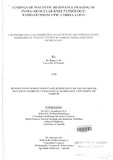Findings of magnetic resonance imaging of intra-articular knee pathology : Radioarthroscopic correlation
Abstract
Males (58.7%) were more affected than females (4l.3%).Majority of the patients were in the 26- 50 years age group, with the right knee (67.4%) being affected more than the left (32.6%). The commonest findings encountered were meniscal tears and joint effusions constituting 78.3% and 65.2% of the cases seen respectively. Both showed a male predilection. Other pathologies seen included chondromalacia patellae, cruciate ligament tears, collateral ligament disruptions, bone bruises, patella tendinosis, synovitis and intraarticular loose bodies.MRI and arthroscopic findings of 46 knees with varied pathologies were reviewed in a retrospective - prospective study that covered the period between January 2006 and August 2007. The Knee magnetic Resonance Imaging was carried out at five Radiological centers providing MRI services in Nairobi. These centers are: 1) Kenyatta National Hospital (KNH); 2) Medical Imaging and Therapeutic Centre-Nairobi (MITC); 3) Aga Khan University Hospital-Nairobi (AKUH); 4) MRI centre-Nairobi and 5) The Nairobi Hospital. The study was carried out in collaboration with two Orthopaedic and Trauma surgeons carrying out Knee arthroscopic surgery in Nairobi. There were 30 retrospective and 16 prospective cases collected during the duration of the study. All the 46 knees included in the study had both MRI findings and corresponding knee arthroscopic data acquired following diagnostic or therapeutic knee arthroscopic surgery. The Knee MRI images / reports done before the surgery and the arthroscopic findings of the corresponding knee formed the basis of this study.
The aim of this study was to determine the pattern of knee joint pathology as seen at five radiological imaging centres in Nairobi by MRI, the age and sex distribution and correlate these findings to the arthroscopic findings.
MRI showed a high sensitivity in the medial meniscus, where it was sensitive in detecting a tear in 8'8.9% of cases. Sensitivity for tears in the lateral meniscus was higher at 93.3%. However, specificity for a meniscal tear was lower in the medial meniscus than in the lateral meniscus (36.1 % and 63.3% respectively). The sensitivity and specificity of the MRI for anterior cruciate ligament rupture (whether complete or partial) was 83.3% and 90.9% respectively, For the articular cartilage, sensitivity was 46.2% and 16.7010 for femoral and tibial articular cartilage abnormalities with a specificity of 8l.8% and 75.0% respectively. The sensitivity and specificity of the MRI for chondromalacia patellae was 26.7% and 8l.8% respectively.
The results of this study support the use of MRI in the diagnosis of internal derangements of the knee. However, it should always be used in conjunction with a full history and clinical examination.
Publisher
University of Nairobi, CHS, Kenya
Description
(data migrated from the old repository)

